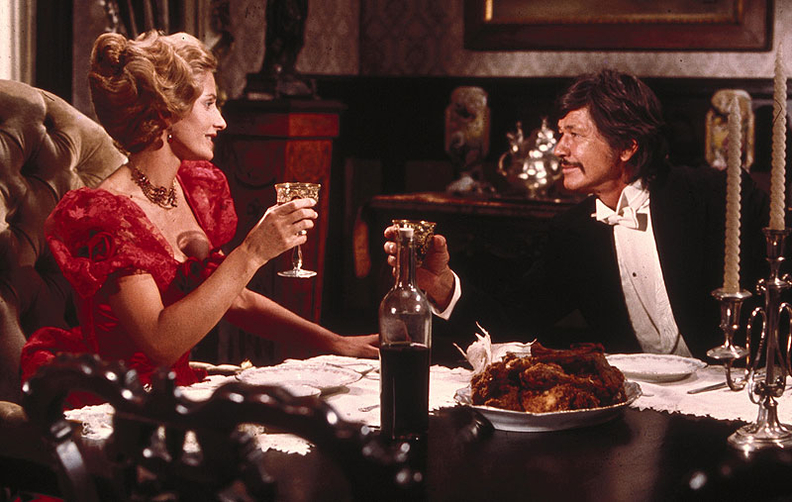Bronson Shines In Light-hearted Western Romp
DIRECTED BY FRANK D. GILROY/1976
STREET DATE: June 13th, 2017/KINO LORBER
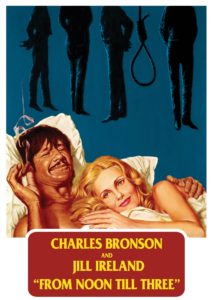 Not to be confused with the unrelated though similarly time-stamped Bronson title 10 to Midnight (’83), an enjoyably trashy exploitation thriller from the actor’s later and lengthy association with Cannon Films, the comparatively sunnier side of the monument-featured, ratchet-voiced action star’s screen persona is explored to lighter, daytime effect in 1976’s offbeat Western romance/parody From Noon Till Three. The time interval of the latter title, recently released by Kino Lorber on DVD, refers to a three-hour period where the film’s “hero”, Graham Dorsey (Bronson), the fifth member of a second-rate gang of bank robbers, lays over at wealthy ranch widow Amanda Starbuck’s (Bronson’s wife and frequent co-star Jill Ireland) lavishly-appointed Victorian barn while his fellow gang members ride into town to rob its bank. The frolicsome afternoon of unambiguously persistent and occasionally untoward “courtship” that follows, while decidedly un-PC from a latter-day perspective, is nonetheless mellow enough in tone, in inimitable mid-70s soft-focus fashion, to overcome this 21st century viewer’s possible discomfort with, say, the warm Western outlaw’s pretense of impotence ultimately winning over the high starch-collared and layered-petticoat reserve of the cold Western widow.
Not to be confused with the unrelated though similarly time-stamped Bronson title 10 to Midnight (’83), an enjoyably trashy exploitation thriller from the actor’s later and lengthy association with Cannon Films, the comparatively sunnier side of the monument-featured, ratchet-voiced action star’s screen persona is explored to lighter, daytime effect in 1976’s offbeat Western romance/parody From Noon Till Three. The time interval of the latter title, recently released by Kino Lorber on DVD, refers to a three-hour period where the film’s “hero”, Graham Dorsey (Bronson), the fifth member of a second-rate gang of bank robbers, lays over at wealthy ranch widow Amanda Starbuck’s (Bronson’s wife and frequent co-star Jill Ireland) lavishly-appointed Victorian barn while his fellow gang members ride into town to rob its bank. The frolicsome afternoon of unambiguously persistent and occasionally untoward “courtship” that follows, while decidedly un-PC from a latter-day perspective, is nonetheless mellow enough in tone, in inimitable mid-70s soft-focus fashion, to overcome this 21st century viewer’s possible discomfort with, say, the warm Western outlaw’s pretense of impotence ultimately winning over the high starch-collared and layered-petticoat reserve of the cold Western widow.
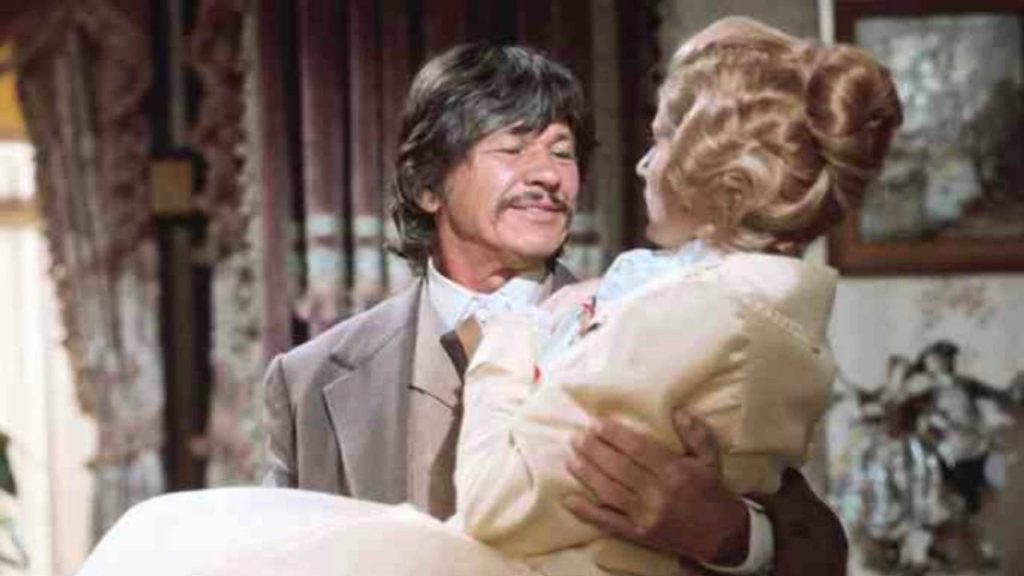
Directed by Frank D. Gilroy, the recipient of the Pulitzer Prize for his 1965 drama The Subject was Roses, the author adapted his own novel towards the third act shift of the Western where, subsequent to the gang members being shot and killed, Dorsey finds himself apprehended under an assumed identity. The widow presuming the outlaw dead, the romantic pair’s memorable three hours are quickly mythologized – through the agency of a highly-romanticized best-seller titled, appropriately, From Noon Till Three – as The Grand Western Romance. Upon his year-later release from prison, Dorsey stumbles into the Western town to find a carnival, guided tours, and stage play presenting the romantic “hero” as 6’3”, Southern, and a fair-skinned gentleman. Bronson is, of course, none of these, and at 5’11”, low-born, and rough-hewn, is eclipsed by his own legend to the point where he remains completely unrecognized. So much so that when he eventually gains entrance to the widow’s house through (continued) subterfuge, his only method of making himself known – even after removing a particularly unconvincing set of false whiskers – is to reveal the unmistakable part of his anatomy from their shared mid-afternoon of thrice-consummated passion. That she almost immediately commits suicide – turning a gun on herself after training it on Dorsey – is undoubtedly a testament to the failure of reality to live up to one’s romantic ideals. (Either that, or the untimely exposure of fleeting passion suddenly proved too much.)
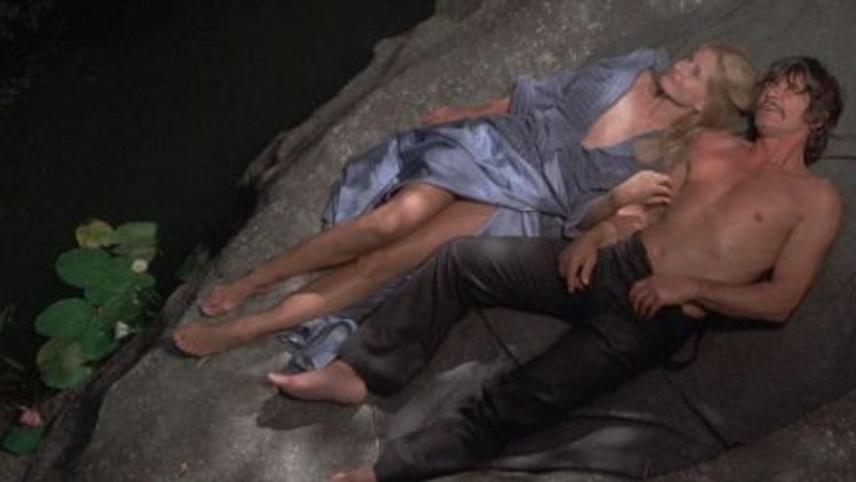
In addition to the oddball bells, toy whistles, and zip-string score from Elmer Bernstein, much of the relative success of this admitted oddity lies in the solid choice of Bronson as its equally solid lead. Incapable of an ungenuine moment on screen, the straight-forward, self-contained qualities of the actor effortlessly make otherwise extreme moments of violence, sexuality, and revenge seem natural extensions of his eternally “present” characters. Having followed Bronson through even the most bitter and vitriolic of the latter-number, Cannon-produced Death Wish sequels, finding inescapable moments of humanity in the otherwise indefensible likes of The Evil that Men Do (’84) and Act of Vengeance (’86), possibly this die-hard Bronson fan is biased, but the sledge-hammer satiric strokes of “printing the legend”, in terms of Western story-telling, gains immeasurably from being sounded by the steely-eyed man’s wide-faced grin upon finally being recognized as “Graham Dorsey” – by inmates of a mental asylum – in the film’s otherwise heavy-handed final shot. Time may have been unkind to the film’s sexual politics and over-deliberate “offbeat” tone, but Bronson moors the Western parody in a “reality” it possibly doesn’t deserve, but which is all the more enjoyable (and actually funnier) for it.
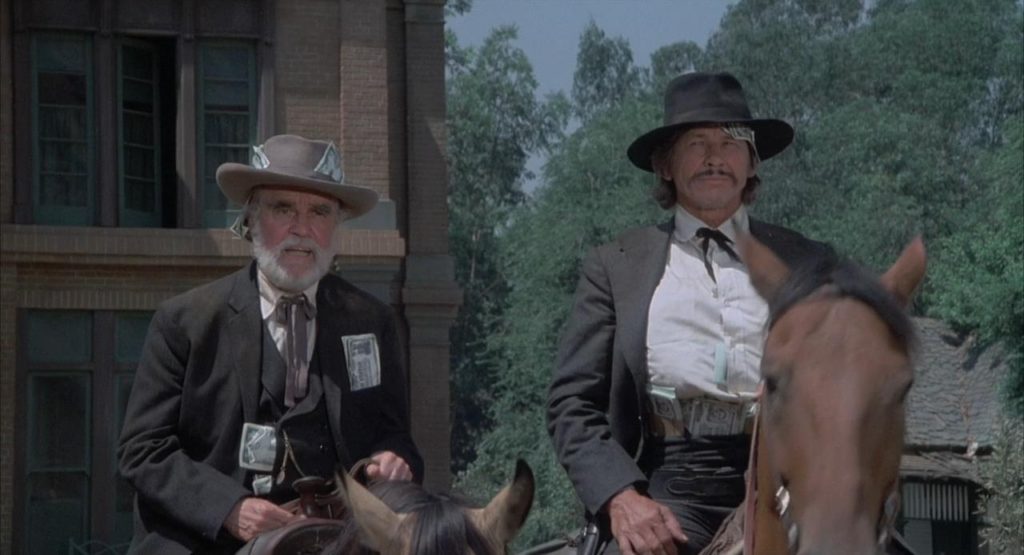
As it stands, however, this DVD will undoubtedly prove the right choice for Westerns and Bronson completists who either don’t have access to high-def viewing or simply don’t want to shell out the extra 20 bucks for competing Twilight Time’s Blu-ray release of the film. From Noon Till Three looks absolutely fine in what we now must term “low-def”, I suppose, and beyond seeing the actual glint in Bronson’s steel eyes, or the crisp details of Lucien Ballard’s photography, Kino Lorber’s more cost-affordable alternative should quite admirably serve a casual, low-maintenance fan’s home-viewing needs. Besides which, not to belabor or stretch a point, but guys like Bronson, Warren Oates, Bruce Dern – who went from one-off(ed) villains in ’50s and ’60s TV Westerns like Gunsmoke, Have Gun, Will Travel, Bonanza to ambivalent “heroes” in ’70s screen fare like Bring Me The Head of Alfredo Garcia, The Laughing Policeman, and Hard Times – always look better to me in low-def, anyway.
The images from this review are used only as a reference to the film and are not meant to represent the image quality of this DVD release.


